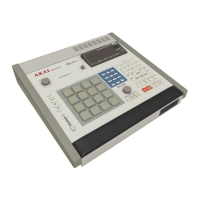18
2.3 The CURSOR keys
While the PLAY/R,ECORD screen is showing, notice that a small
rectangular block is blinking near the upper left corner. This is called the
CURSOR. It is possible to move the cursor around the screen using the
four grey direction keys in the CURSOR section of the panel. Try doing
this, then return the cursor to the upper left corner where it was.
Notice that the cursor does not move from letter to letter, but rather
jumps across many letters at a time, landing only in certain locations,
usually to the right of a colon (":"). These areas are called DATA FIELDS
and each one controls a specific parameter. For example, the upper
leftmost data field is called SQNC, an abbreviation for "sequence". To the
right of this field is another field containing the name for the selected
sequence number, followed by the TMPO field, an abbreviation for
"tempo".
The PLAY/R,ECORD screen is one of many screens available on the
MPC60. Each of the panel keys presents at least one unique screen, and each
screen has its own unique data fields. Try pressing a few of the different keys
in the COMMANDS section of the panel such as DISK or TEMPO/SYNC.
When you're finished, press MAIN SCREEN to return to the
PLAY/RECORD screen.

